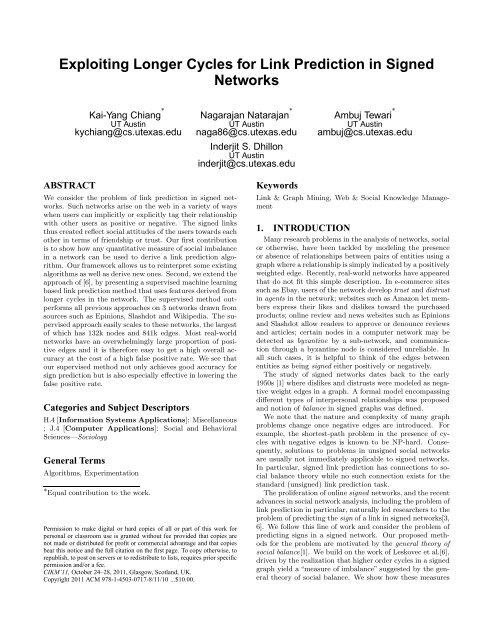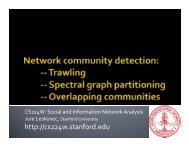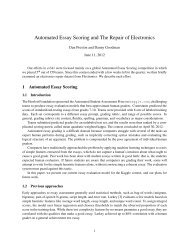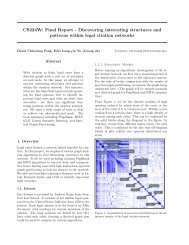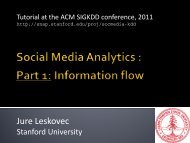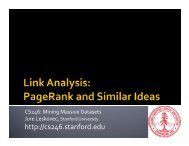Exploiting Longer Cycles for Link Prediction in Signed Networks
Exploiting Longer Cycles for Link Prediction in Signed Networks
Exploiting Longer Cycles for Link Prediction in Signed Networks
You also want an ePaper? Increase the reach of your titles
YUMPU automatically turns print PDFs into web optimized ePapers that Google loves.
<strong>Exploit<strong>in</strong>g</strong> <strong>Longer</strong> <strong>Cycles</strong> <strong>for</strong> <strong>L<strong>in</strong>k</strong> <strong>Prediction</strong> <strong>in</strong> <strong>Signed</strong><br />
<strong>Networks</strong><br />
ABSTRACT<br />
Kai-Yang Chiang ∗<br />
UT Aust<strong>in</strong><br />
kychiang@cs.utexas.edu<br />
We consider the problem of l<strong>in</strong>k prediction <strong>in</strong> signed networks.<br />
Such networks arise on the web <strong>in</strong> a variety of ways<br />
when users can implicitly or explicitly tag their relationship<br />
with other users as positive or negative. The signed l<strong>in</strong>ks<br />
thus created reflect social attitudes of the users towards each<br />
other <strong>in</strong> terms of friendship or trust. Our first contribution<br />
is to show how any quantitative measure of social imbalance<br />
<strong>in</strong> a network can be used to derive a l<strong>in</strong>k prediction algorithm.<br />
Our framework allows us to re<strong>in</strong>terpret some exist<strong>in</strong>g<br />
algorithms as well as derive new ones. Second, we extend the<br />
approach of [6], by present<strong>in</strong>g a supervised mach<strong>in</strong>e learn<strong>in</strong>g<br />
based l<strong>in</strong>k prediction method that uses features derived from<br />
longer cycles <strong>in</strong> the network. The supervised method outper<strong>for</strong>ms<br />
all previous approaches on 3 networks drawn from<br />
sources such as Ep<strong>in</strong>ions, Slashdot and Wikipedia. The supervised<br />
approach easily scales to these networks, the largest<br />
of which has 132k nodes and 841k edges. Most real-world<br />
networks have an overwhelm<strong>in</strong>gly large proportion of positive<br />
edges and it is there<strong>for</strong>e easy to get a high overall accuracy<br />
at the cost of a high false positive rate. We see that<br />
our supervised method not only achieves good accuracy <strong>for</strong><br />
sign prediction but is also especially effective <strong>in</strong> lower<strong>in</strong>g the<br />
false positive rate.<br />
Categories and Subject Descriptors<br />
H.4 [In<strong>for</strong>mation Systems Applications]: Miscellaneous<br />
; J.4 [Computer Applications]: Social and Behavioral<br />
Sciences—Sociology<br />
General Terms<br />
Algorithms, Experimentation<br />
∗ Equal contribution to the work.<br />
Permission to make digital or hard copies of all or part of this work <strong>for</strong><br />
personal or classroom use is granted without fee provided that copies are<br />
not made or distributed <strong>for</strong> profit or commercial advantage and that copies<br />
bear this notice and the full citation on the first page. To copy otherwise, to<br />
republish, to post on servers or to redistribute to lists, requires prior specific<br />
permission and/or a fee.<br />
CIKM’11, October 24–28, 2011, Glasgow, Scotland, UK.<br />
Copyright 2011 ACM 978-1-4503-0717-8/11/10 ...$10.00.<br />
Nagarajan Natarajan ∗<br />
UT Aust<strong>in</strong><br />
naga86@cs.utexas.edu<br />
Inderjit S. Dhillon<br />
UT Aust<strong>in</strong><br />
<strong>in</strong>derjit@cs.utexas.edu<br />
Keywords<br />
Ambuj Tewari ∗<br />
UT Aust<strong>in</strong><br />
ambuj@cs.utexas.edu<br />
<strong>L<strong>in</strong>k</strong> & Graph M<strong>in</strong><strong>in</strong>g, Web & Social Knowledge Management<br />
1. INTRODUCTION<br />
Many research problems <strong>in</strong> the analysis of networks, social<br />
or otherwise, have been tackled by model<strong>in</strong>g the presence<br />
or absence of relationships between pairs of entities us<strong>in</strong>g a<br />
graph where a relationship is simply <strong>in</strong>dicated by a positively<br />
weighted edge. Recently, real-world networks have appeared<br />
that do not fit this simple description. In e-commerce sites<br />
such as Ebay, users of the network develop trust and distrust<br />
<strong>in</strong> agents <strong>in</strong> the network; websites such as Amazon let members<br />
express their likes and dislikes toward the purchased<br />
products; onl<strong>in</strong>e review and news websites such as Ep<strong>in</strong>ions<br />
and Slashdot allow readers to approve or denounce reviews<br />
and articles; certa<strong>in</strong> nodes <strong>in</strong> a computer network may be<br />
detected as byzant<strong>in</strong>e by a sub-network, and communication<br />
through a byzant<strong>in</strong>e node is considered unreliable. In<br />
all such cases, it is helpful to th<strong>in</strong>k of the edges between<br />
entities as be<strong>in</strong>g signed either positively or negatively.<br />
The study of signed networks dates back to the early<br />
1950s [1] where dislikes and distrusts were modeled as negative<br />
weight edges <strong>in</strong> a graph. A <strong>for</strong>mal model encompass<strong>in</strong>g<br />
different types of <strong>in</strong>terpersonal relationships was proposed<br />
and notion of balance <strong>in</strong> signed graphs was def<strong>in</strong>ed.<br />
We note that the nature and complexity of many graph<br />
problems change once negative edges are <strong>in</strong>troduced. For<br />
example, the shortest-path problem <strong>in</strong> the presence of cycles<br />
with negative edges is known to be NP-hard. Consequently,<br />
solutions to problems <strong>in</strong> unsigned social networks<br />
are usually not immediately applicable to signed networks.<br />
In particular, signed l<strong>in</strong>k prediction has connections to social<br />
balance theory while no such connection exists <strong>for</strong> the<br />
standard (unsigned) l<strong>in</strong>k prediction task.<br />
The proliferation of onl<strong>in</strong>e signed networks, and the recent<br />
advances <strong>in</strong> social network analysis, <strong>in</strong>clud<strong>in</strong>g the problem of<br />
l<strong>in</strong>k prediction <strong>in</strong> particular, naturally led researchers to the<br />
problem of predict<strong>in</strong>g the sign of a l<strong>in</strong>k <strong>in</strong> signed networks[3,<br />
6]. We follow this l<strong>in</strong>e of work and consider the problem of<br />
predict<strong>in</strong>g signs <strong>in</strong> a signed network. Our proposed methods<br />
<strong>for</strong> the problem are motivated by the general theory of<br />
social balance[1]. We build on the work of Leskovec et al.[6],<br />
driven by the realization that higher order cycles <strong>in</strong> a signed<br />
graph yield a “measure of imbalance” suggested by the general<br />
theory of social balance. We show how these measures
can be successfully exploited <strong>for</strong> sign prediction. We also go<br />
beyond these simple measures of imbalance and propose a<br />
supervised mach<strong>in</strong>e learn<strong>in</strong>g approach that achieves stateof-the-art<br />
per<strong>for</strong>mance on datasets drawn from sources as<br />
diverse as Ep<strong>in</strong>ions, Slashdot and Wikipedia. Our largest<br />
network has more than 100k nodes and 800k edges. Our<br />
ma<strong>in</strong> contributions can be summarized as follows. First,<br />
we show how any quantitative measure of imbalance <strong>in</strong> a<br />
network can be used to derive a l<strong>in</strong>k prediction algorithm.<br />
We discuss different measures of imbalance that are derived<br />
from social balance theory and signed graph theory. In particular,<br />
we show that the Katz measure on a signed graph is<br />
quite naturally connected to a measure of imbalance. Second,<br />
we show that us<strong>in</strong>g measures of imbalance that depend<br />
on higher order cycles can improve the quality of sign prediction.<br />
The effect is more pronounced <strong>in</strong> the case of edges<br />
with zero embeddedness. The nodes of such edges, by def<strong>in</strong>ition,<br />
do not share any common neighbors. Third, our supervised<br />
learn<strong>in</strong>g approach to sign prediction uses features<br />
derived from longer cycles and achieves state-of-the-art per<strong>for</strong>mance.<br />
In particular, our method has smaller false positive<br />
rate, compared to the methods <strong>in</strong> [6]. Moreover, the<br />
per<strong>for</strong>mance improvement is consistent across diverse networks<br />
(<strong>in</strong> the sense of <strong>for</strong>mation and composition of signed<br />
edges) such as Ep<strong>in</strong>ions, Slashdot and Wikipedia.<br />
Our experiments with real-world networks show that not<br />
all relationships <strong>for</strong>med <strong>in</strong> a social network con<strong>for</strong>m to the<br />
<strong>in</strong>tuitions underly<strong>in</strong>g social balance theory. Indeed, we f<strong>in</strong>d<br />
that real-world networks are too complex to be described<br />
by a simple <strong>for</strong>malism. Given the complexity of these networks,<br />
longer cycles seem to conta<strong>in</strong> <strong>in</strong> them more useful<br />
<strong>in</strong><strong>for</strong>mation <strong>for</strong> predict<strong>in</strong>g signs of l<strong>in</strong>ks.<br />
2. RELATED WORK<br />
<strong>Signed</strong> networks have received attention <strong>in</strong> the last decade<br />
<strong>in</strong> the context of cluster<strong>in</strong>g and l<strong>in</strong>k prediction. The problem<br />
of predict<strong>in</strong>g edge signs <strong>in</strong> a social network was first considered<br />
by Guha et al.[3], albeit <strong>in</strong> a slightly different sett<strong>in</strong>g.<br />
They develop a trust propagation framework to predict the<br />
trust (or distrust) between pairs of nodes. First, a comb<strong>in</strong>ed<br />
matrix is derived from the adjacency matrix which captures<br />
all one-step propagations (correspond<strong>in</strong>g to cases k = 2 and<br />
k = 3 <strong>in</strong> our k-cycle method). The propagated trusts and<br />
distrusts are then computed as a l<strong>in</strong>ear comb<strong>in</strong>ation of powers<br />
of the comb<strong>in</strong>ed matrix. They apply variants of their<br />
method on the Ep<strong>in</strong>ions network and f<strong>in</strong>d that higher iterations<br />
of propagation tend to have a beneficial effect on the<br />
accuracy of prediction.<br />
Kunegis et al.[5] study the spectral properties of signed<br />
networks and use kernels derived from a signed variant of<br />
the graph Laplacian <strong>for</strong> l<strong>in</strong>k prediction. They also consider<br />
power sum of the adjacency matrix (up to degree 4) <strong>for</strong> l<strong>in</strong>k<br />
prediction. However, they do not propose any supervised<br />
learn<strong>in</strong>g approach that learns the coefficients <strong>in</strong> their models.<br />
Leskovec et al.[6] first considered an explicit <strong>for</strong>mulation<br />
of the sign prediction problem. Their prediction methods are<br />
based on the theory of social balance and status[7]. The idea<br />
is that the sign of an edge (i, j) should m<strong>in</strong>imize the number<br />
of unbalanced triangles <strong>in</strong>volv<strong>in</strong>g the edge (i, j), i.e. triangles<br />
with an odd number of negative edges (see Section 4). They<br />
also propose a supervised mach<strong>in</strong>e-learn<strong>in</strong>g <strong>for</strong>mulation of<br />
the problem, and show that the features derived from different<br />
types of triangles, comb<strong>in</strong>ed with first-order features<br />
of a node like the number of <strong>in</strong>com<strong>in</strong>g positive edges, make<br />
better predictors of the edge sign. The prediction model is<br />
also shown to generalize fairly well across different onl<strong>in</strong>e social<br />
networks. Their model, however, does not look beyond<br />
such local structures as triangles. These local features lead<br />
to impressive accuracies <strong>in</strong> the networks that they consider.<br />
Nevertheless, it is natural to ask if the acccuracy can be<br />
further boosted by consider<strong>in</strong>g higher order features.<br />
3. PRELIMINARIES<br />
For us, a graph will mean a signed graph unless otherwise<br />
stated. This <strong>for</strong>mally means that G = (V, E, Σ) where<br />
V = {1, 2, . . . , |V |} is a f<strong>in</strong>ite set of nodes or vertices of the<br />
graph. The set E consists of edges of the <strong>for</strong>m {i, j} or (i, j),<br />
<strong>for</strong> i, j ∈ V , depend<strong>in</strong>g on whether the graph is undirected or<br />
directed (we assume there are no self-loops). The third component<br />
of a graph is a mapp<strong>in</strong>g Σ : E → {+1, −1} giv<strong>in</strong>g a<br />
sign to each edge. We will assume that our graphs are connected<br />
(weakly connected if directed). We will use the terms<br />
‘network’ and ‘graph’ <strong>in</strong>terchangeably. An undirected graph<br />
has an associated adjacency matrix A ∈ {−1, 0, +1} |V |×|V | .<br />
For undirected graphs, A is symmetric, i.e. A = A T , while<br />
<strong>for</strong> directed graphs it will not be symmetric <strong>in</strong> general. It<br />
will also be convenient to def<strong>in</strong>e the positive part A + and<br />
negative part A − as: A + := max(A,0), A − := m<strong>in</strong>(A,0)<br />
where max/m<strong>in</strong> are applied entry-wise. With these def<strong>in</strong>itions,<br />
we have A = A + + A − .<br />
A path (of length or order k) <strong>in</strong> an undirected graph is<br />
a sequence i1, i2, . . . , ik+1 of vertices such that {ij, ij+1} is<br />
an edge <strong>for</strong> 1 ≤ j ≤ k. A simple path is a path with no<br />
repeated vertices. A cycle is a path with i1 = ik+1. A<br />
simple cycle is a cycle with no repeated vertices (except the<br />
first one). Similar def<strong>in</strong>itions yield paths, simple paths, cycle<br />
and simple cycles <strong>in</strong> directed graphs. Denote the set of all<br />
order k cycles and simple cycles of a graph G by Ck(G) and<br />
SCk(G) respectively. The <strong>in</strong>dicator 1[P] is 1 if predicate P<br />
is true and 0 otherwise. We let power take precedence over<br />
subscript, i.e. A k i,j denotes (A k )i,j.<br />
3.1 Problem set-up<br />
We adopt the framework [3, 6] of predict<strong>in</strong>g the sign of<br />
a s<strong>in</strong>gle edge that has been suppressed, us<strong>in</strong>g the rest of<br />
the network. Formally, given a graph G = (V, E, Σ), and<br />
a test edge etest ∈ E, we want to predict Σ(etest), us<strong>in</strong>g<br />
only the edges <strong>in</strong> E − {etest}. When us<strong>in</strong>g a supervised<br />
mach<strong>in</strong>e learn<strong>in</strong>g approach it is convenient to th<strong>in</strong>k of {e ′ ∈<br />
E−{etest} : Σ(e ′ ) = +1} and {e ′ ∈ E−{etest} : Σ(e ′ ) = −1}<br />
as the set of positive and negative examples respectively.<br />
3.2 Basics of Social Balance Theory<br />
We briefly review the rudiments of the theory of social balance.<br />
This theory rests on the premise that certa<strong>in</strong> configurations<br />
of positive (‘is a friend of’ or ‘trusts’) and negative<br />
(‘is an enemy of’ or ‘distrusts’) edges between <strong>in</strong>dividuals<br />
are socially more plausible than others. A more detailed<br />
treatment can be found <strong>in</strong> [2, Chapter 5]. For example, <strong>in</strong><br />
the case of three <strong>in</strong>dividuals a, b and c, the left two configurations<br />
below are more likely than the right two:<br />
a +<br />
b<br />
+<br />
+ c<br />
a −<br />
b<br />
+<br />
− c<br />
a −<br />
b<br />
−<br />
− c<br />
a +<br />
b<br />
−<br />
+ c
on the basis of say<strong>in</strong>gs such as ‘a friend of a friend is a friend’<br />
and ‘an enemy of an enemy is a friend’. Accord<strong>in</strong>gly, the first<br />
two triangles are called balanced while the latter two are said<br />
to be unbalanced. Formally, a complete undirected signed<br />
graph is called balanced iff all triangles <strong>in</strong> it are balanced. Of<br />
course, real world networks are not complete by any means.<br />
Hence, the notion of balance can be extended by us<strong>in</strong>g the<br />
idea of fill<strong>in</strong>g <strong>in</strong> miss<strong>in</strong>g entries. An undirected signed graph<br />
is called balanced iff it is possible to add signed edges to<br />
make it a balanced and complete graph. It turns out that<br />
this ‘local’ def<strong>in</strong>ition based on look<strong>in</strong>g at triangles only is<br />
equivalent to a ‘global’ def<strong>in</strong>ition where we say that a graph<br />
is balanced if and only if its vertices can be divided <strong>in</strong>to two<br />
mutually exclusive and exhaustive sets X and Y (with one<br />
of them possibly empty) such that all edges with<strong>in</strong> X and<br />
with<strong>in</strong> Y are positive while all edges with one end <strong>in</strong> X and<br />
the other <strong>in</strong> Y are negative.<br />
The follow<strong>in</strong>g theorem relates balance to the existence of<br />
simple cycles with an odd number of negative edges.<br />
Theorem 1. ([4, 1]) A signed graph is balanced iff there<br />
are no simple cycles with odd number of negative edges.<br />
Motivated by this theorem, we call a cycle (simple or otherwise)<br />
balanced if it has an even number of negative edges<br />
and unbalanced otherwise.<br />
4. METHODS BASED ON MEASURES OF<br />
SOCIAL IMBALANCE<br />
The ma<strong>in</strong> idea developed <strong>in</strong> this section is that any quantitative<br />
measure of social imbalance <strong>in</strong> a graph can be used<br />
to design a l<strong>in</strong>k prediction algorithm. The sign prediction<br />
<strong>for</strong> a given edge is the one that m<strong>in</strong>imizes the social imbalance<br />
<strong>in</strong> the result<strong>in</strong>g graph (once the signed edge has been<br />
added to the network).<br />
In a complete graph, perfect balance, by def<strong>in</strong>ition, implies<br />
the absence of any unbalanced triangles. This motivates a<br />
simple measure of imbalance, namely the total number of<br />
unbalanced triangles <strong>in</strong> a graph. Thus, we def<strong>in</strong>e,<br />
µtri(G) := X<br />
1[˜σ is unbalanced] . (1)<br />
˜σ∈SC3(G)<br />
A def<strong>in</strong>ition essentially similar to the one above appears <strong>in</strong><br />
the recent work of van de Rijt [10, p. 103] who observes that<br />
the equivalence between µtri(G) = 0 and G be<strong>in</strong>g balanced<br />
holds only <strong>for</strong> complete graphs.<br />
For an <strong>in</strong>complete graph, imbalance might manifest itself<br />
only if we look at longer simple cycles. Accord<strong>in</strong>gly, we<br />
def<strong>in</strong>e a higher-order analogue of (1),<br />
µ s k(G) :=<br />
kX<br />
i=3<br />
βi<br />
X<br />
˜σ∈SC i(G)<br />
1[˜σ is unbalanced] . (2)<br />
where k ≥ 3 and βi’s are coefficients weight<strong>in</strong>g the relative<br />
contributions of unbalanced simple cycles of different<br />
lengths. If we choose a decay<strong>in</strong>g choice of βi, like βi = β i<br />
<strong>for</strong> some β ∈ (0,1), then we can even def<strong>in</strong>e an <strong>in</strong>f<strong>in</strong>iteorder<br />
version µ s ∞(G) by sett<strong>in</strong>g k = ∞ above. It is clear<br />
that µ∞(·) is a genu<strong>in</strong>e measure of imbalance <strong>in</strong> the sense<br />
<strong>for</strong>malized by the follow<strong>in</strong>g theorem which follows directly<br />
from Theorem 1).<br />
Theorem 2. Fix a (possibly <strong>in</strong>complete) graph G. Let<br />
βi > 0 be any sequence such that µ s ∞(G) is well-def<strong>in</strong>ed.<br />
Then, µ∞(G) > 0 iff G is unbalanced.<br />
This suggests that we could use µ∞(·) as a measure of<br />
imbalance to derive l<strong>in</strong>k prediction algorithms. However,<br />
enumerat<strong>in</strong>g simple cycles of a graph is a hard problem. In<br />
particular, if we could count simple cycles of length n <strong>in</strong><br />
a graph with n vertices <strong>in</strong> polynomial time, we would solve<br />
the NP-complete Hamiltonian cycle problem. To get around<br />
this computational issue, we slightly change the def<strong>in</strong>ition of<br />
µk(·) to the follow<strong>in</strong>g.<br />
µk(G) :=<br />
kX<br />
i=3<br />
βi<br />
X<br />
σ∈C i(G)<br />
1[σ is unbalanced] . (3)<br />
As be<strong>for</strong>e, we allow k = ∞ provided the βi’s decay sufficiently<br />
rapidly. The only difference between these def<strong>in</strong>itions<br />
and the previous one is that here we sum over all cycles, not<br />
just simple ones. However, we still get a valid notion of imbalance<br />
as stated by the follow<strong>in</strong>g result (proof will be given<br />
<strong>in</strong> a longer version of the paper).<br />
Theorem 3. Fix a (possibly <strong>in</strong>complete) graph G. Let<br />
βi > 0 be any sequence such that µ∞(G) is well-def<strong>in</strong>ed.<br />
Then, µ∞(G) > 0 iff G is unbalanced.<br />
The basic idea of us<strong>in</strong>g a measure of imbalance <strong>for</strong> predict<strong>in</strong>g<br />
the sign of a given query l<strong>in</strong>k i, j, such that i = j and<br />
{i, j} ∈ E is as follows. Given a graph G and query {i, j} <strong>for</strong><br />
i, j ∈ V, i = j, we construct two graphs: G +(i,j) and G −(i,j) .<br />
These are obta<strong>in</strong>ed from G by augment<strong>in</strong>g its edge-set with<br />
{i, j} and attach<strong>in</strong>g a +1 and −1 sign to it respectively.<br />
Given a measure of imbalance, µ(·), the predicted sign of<br />
{i, j} is then simply:<br />
sign<br />
“<br />
µ<br />
“<br />
G −(i,j)”<br />
− µ<br />
“<br />
G +(i,j)””<br />
. (4)<br />
Note that, to be able to this quickly, we should use a µ(·)<br />
<strong>for</strong> which the quantity (4) is efficiently computable. We now<br />
consider the measures mentioned <strong>in</strong> the previous subsection<br />
to ensure that this is <strong>in</strong>deed the case <strong>for</strong> them.<br />
Somewhat surpris<strong>in</strong>gly, <strong>for</strong> µ(·) = µ3(·), the prediction (4)<br />
simply amounts to comput<strong>in</strong>g the (i, j) entry <strong>in</strong> the matrix<br />
A 2 where A is the (signed) adjacency matrix of G. In fact,<br />
a more general result is true (proof will be given <strong>in</strong> a longer<br />
version of the paper).<br />
Theorem 4. Let G = (V, E,Σ) be an undirected signed<br />
graph and let i = j be such that {i, j} /∈ E. Let G +(i,j) and<br />
G −(i,j) be the augmented graphs as def<strong>in</strong>ed above. Then, <strong>for</strong><br />
any k ≥ 2,<br />
X<br />
σ∈C k(G −(i,j) )<br />
1[σ] −<br />
X<br />
σ∈C k(G +(i,j) )<br />
1[σ] = A k−1<br />
i,j<br />
where A ∈ {−1, 0,+1} |V |×|V | is the adjacency matrix of G.<br />
Us<strong>in</strong>g Theorem 4, it is easy to see that<br />
“ “<br />
sign µk G −(i,j)”<br />
“<br />
− µk G +(i,j)””<br />
= sign<br />
kX<br />
t=3<br />
βtA t−1<br />
i,j<br />
and that the above is true even <strong>for</strong> k = ∞. In the special<br />
case βk = β k−1 with β < 1/A2, we can sum the<br />
above <strong>in</strong>f<strong>in</strong>ite series to “ get the Katz prediction rule <strong>for</strong> edge<br />
`(I ´ ”<br />
−1<br />
sign prediction: sign − βA) − I − βA . Katz has<br />
i,j<br />
been successfully used as a l<strong>in</strong>k prediction method <strong>for</strong> unsigned<br />
networks [8] but here we see it reappear<strong>in</strong>g <strong>for</strong> l<strong>in</strong>k<br />
!
prediction <strong>in</strong> signed networks from a social balance po<strong>in</strong>t of<br />
view. We f<strong>in</strong>d this connection between Katz and social balance<br />
<strong>in</strong>trigu<strong>in</strong>g and believe, to the best of our knowledge,<br />
that it has not been made be<strong>for</strong>e.<br />
5. SUPERVISED METHOD BASED ON<br />
LONGER CYCLES<br />
The methods derived from the measures of imbalance <strong>in</strong><br />
the previous section rely on social balance theory <strong>for</strong> l<strong>in</strong>k<br />
prediction <strong>in</strong> signed networks. However, real world networks<br />
may not con<strong>for</strong>m to the prediction of social balance theory<br />
or may do so only to a certa<strong>in</strong> extent. To deal with this situation,<br />
we use measures such as Katz to derive features that<br />
can then be fed to a supervised mach<strong>in</strong>e learn<strong>in</strong>g algorithm<br />
along with the signs of the known edges <strong>in</strong> the network. We<br />
draw upon research <strong>in</strong> unsigned l<strong>in</strong>k prediction where the<br />
Katz measure has been empirically demonstrated to produce<br />
competitive results [8]. However, recent research [9] shows<br />
that learn<strong>in</strong>g the weights βi based on supervised mach<strong>in</strong>e<br />
learn<strong>in</strong>g approaches tends to <strong>in</strong>crease l<strong>in</strong>k prediction accuracy.<br />
It is thus natural to expect that the relative weights <strong>for</strong><br />
cycles of various lengths may be better estimated by tak<strong>in</strong>g<br />
<strong>in</strong>to account the evidence <strong>in</strong> the tra<strong>in</strong><strong>in</strong>g data correspond<strong>in</strong>g<br />
to the given network.<br />
We pose the problem of predict<strong>in</strong>g the sign of an observed<br />
l<strong>in</strong>k as a standard (b<strong>in</strong>ary) classification problem <strong>in</strong> mach<strong>in</strong>e<br />
learn<strong>in</strong>g, us<strong>in</strong>g positive and negative examples. Our tra<strong>in</strong><strong>in</strong>g<br />
set consists of pairs (e,Σ(e)) where e ranges over edges whose<br />
signs are given to us and Σ(e)’s are the given signs. Given<br />
the dataset, we wish to learn a classifier that can predict<br />
the sign of a given test edge etest that was not part of the<br />
tra<strong>in</strong><strong>in</strong>g set.<br />
We now extend the supervised learn<strong>in</strong>g approach of [6]<br />
by <strong>in</strong>troduc<strong>in</strong>g features derived from longer cycles. In the<br />
process, we obta<strong>in</strong> supervised variants of the cycle-based<br />
sign prediction methods <strong>in</strong>troduced <strong>in</strong> the previous section.<br />
5.1 Features from <strong>Longer</strong> <strong>Cycles</strong><br />
Let us now describe the features of a directed edge e =<br />
(i, j). Note that, unlike methods presented <strong>in</strong> Section 4,<br />
we here consider directed signed networks. Social balance<br />
theory has mostly been concerned with undirected network<br />
and hence the methods <strong>in</strong> Section 4 deal with undirected<br />
networks only. Here, we are weaken<strong>in</strong>g our reliance on social<br />
balance theory and can there<strong>for</strong>e naturally deal with<br />
directed graphs as well.<br />
To motivate our longer cycle based features, let us first<br />
recall the feature construction used <strong>in</strong> Leskovec et al [6]. Fix<br />
an edge e = (i, j). Consider an arbitary common neighbor<br />
(<strong>in</strong> an undirected sense) k of i and j. The l<strong>in</strong>k between i and<br />
k can be <strong>in</strong> 4 possible configurations: i + → k, i + ← k i − → k,<br />
or i − ← k. Similarly, there are 4 possible configurations <strong>for</strong><br />
the l<strong>in</strong>k between k and j. Thus, we can get a total of 16<br />
features <strong>for</strong> the edge e by consider<strong>in</strong>g the number of common<br />
neighbors k <strong>in</strong> each of the 4 × 4 = 16 configurations.<br />
This corresponds to a supervised variant of k-cycle method<br />
<strong>for</strong> k = 3. In terms of matrix powers, these sixteen features<br />
are noth<strong>in</strong>g but the (i, j) entry <strong>in</strong> the sixteen matrices:<br />
(A b1 ) t1 · (A b2 ) t3 where b1, b2 ∈ {±} and ti ∈ {T, 1}. A criticism<br />
aga<strong>in</strong>st us<strong>in</strong>g only these triangle-based features is that<br />
there could be many people <strong>in</strong> the social network who do<br />
not share friends. In fact, this is the case <strong>in</strong> most of the net-<br />
Table 1: Network Statistics<br />
Ep<strong>in</strong>ions Slashdot Wikipedia<br />
No. of nodes 131, 828 82, 144 7,065<br />
No. of edges 840, 799 549, 202 103, 561<br />
Fraction of + edges 0.8529 0.7740 0.7884<br />
Fraction of − edges 0.1471 0.2260 0.2116<br />
Normalized MOI-3 0.0950 0.1335 0.2165<br />
works that are used <strong>in</strong> [6]. The reason their method is able<br />
to predict well on such pairs is that they additionally use<br />
7 “degree-type” features like <strong>in</strong>-degree and out-degree (and<br />
their signed variants). Thus, the prediction <strong>for</strong> edge with<br />
zero emdeddedness (embeddedness refers to the number of<br />
common neighbors of the vertices of an edge) relies completely<br />
on such degree based features. These degree features<br />
tend to <strong>in</strong>troduce a bias <strong>in</strong> learn<strong>in</strong>g. For example, a node<br />
that is predisposed to make positive relationships, biases the<br />
classifier to predict positive relationships.<br />
This criticism thus necessitates <strong>in</strong>corporat<strong>in</strong>g features from<br />
higher-order cycles. Generaliz<strong>in</strong>g the construction <strong>for</strong> k = 3<br />
case, <strong>for</strong> the edge (i, j), the features can be obta<strong>in</strong>ed as the<br />
(i, j) entries <strong>in</strong> the 4 k−1 matrices<br />
“<br />
A b1<br />
” t1<br />
·<br />
“<br />
A b2<br />
” t2<br />
. . . ·<br />
“<br />
A b ” tk−1<br />
k−1<br />
, (5)<br />
with bi ∈ {±}, ti ∈ {T,1}.<br />
Note that the number of features is exponential <strong>in</strong> k, and<br />
there<strong>for</strong>e it is not feasible to obta<strong>in</strong> features from arbitrarily<br />
long cycles. We use supervised higher order cycle (HOC)<br />
methods <strong>for</strong> k ≤ 5 <strong>in</strong> the experiments.<br />
The number of features can quickly become unmanageable,<br />
and computationally <strong>in</strong>feasible, as soon as k is beyond<br />
5. While dimensionality of the feature space may be the primary<br />
concern, the comb<strong>in</strong>atorial nature of the features also<br />
raises the follow<strong>in</strong>g <strong>in</strong>tuitive concern: the <strong>in</strong>terpretability<br />
of features rendered by high-order cycles, say when k = 6,<br />
composed of different signs and directions, is a challenge.<br />
For example, it is <strong>in</strong>tuitively hard to appreciate the differ-<br />
+<br />
→ k2<br />
−<br />
→ k3<br />
+<br />
→ k4<br />
+<br />
→ j and<br />
ence between two walks i + → k1<br />
i + + − + +<br />
→ k1 → k2 ← k3 → k4 → j.<br />
With this realization, one way to reduce the number of<br />
features yet reta<strong>in</strong> the <strong>in</strong><strong>for</strong>mation <strong>in</strong> longer cycles, is to<br />
consider the underly<strong>in</strong>g undirected graph, ignor<strong>in</strong>g the directions.<br />
In particular, the kth order features will be from<br />
the matrices A b1 b2 b<br />
· A . . . · A k−1 with bi ∈ {±}. S<strong>in</strong>ce we<br />
are consider<strong>in</strong>g the undirected graph, we ensure that the features<br />
are symmetric by summ<strong>in</strong>g features of the <strong>for</strong>m A b1 b2 A<br />
and A b2 b1 A . Thus the number of k-th order features to compute<br />
is reduced to O(2 k ) from O(4 k ). Though the number of<br />
features is still exponential <strong>in</strong> k, the construction of features<br />
becomes much easier <strong>for</strong> small values of k.<br />
We use a simple logistic regression where the imbalance<br />
of an edge is modeled as a l<strong>in</strong>ear comb<strong>in</strong>ation of the features,<br />
which are imbalances <strong>in</strong> cycles of various lengths and<br />
characteristics themselves. Let Φ : V × V → R p denote<br />
the feature map. We have, P(Σ(u, v) = +1) = 1/(1 +<br />
exp ` −w0 − Pp i=1 wiΦi(u, v)´ ). The prediction <strong>for</strong> edge (u, v)<br />
is given by sign(〈w,Φ(u, v)〉).<br />
6. EXPERIMENTS<br />
We consider three onl<strong>in</strong>e social networks — Ep<strong>in</strong>ions, Slashdot<br />
and Wikipedia[6] (downloaded from snap.stan<strong>for</strong>d.
Table 2: Accuracy of HOC Methods<br />
Ep<strong>in</strong>ions Slashdot Wikipedia<br />
HOC-3 0.9014 0.8303 0.8424<br />
HOC-5 0.9080 0.8469 0.8605<br />
Table 3: False Positive Rate of HOC Methods<br />
Ep<strong>in</strong>ions Slashdot Wikipedia<br />
HOC-3 0.4756 0.5575 0.5488<br />
HOC-5 0.4441 0.5070 0.4817<br />
edu). All the networks have explicit sign labels on the l<strong>in</strong>ks.<br />
Refer to Table 1 <strong>for</strong> the statistics of the networks. Note that<br />
MOI-3 is normalized by the total number of triangles. Refer<br />
to [6] <strong>for</strong> description of the networks. We have 2 families of<br />
methods: one based on measures of imbalance (MOI) from<br />
Section 4 and the other based on the supervised mach<strong>in</strong>e<br />
learn<strong>in</strong>g approach <strong>in</strong>volv<strong>in</strong>g higher order cycles (HOC) described<br />
<strong>in</strong> Section 5. Both families depend on a parameter<br />
k ≥ 3 that denotes the order of the cycles that the method<br />
is based on. For MOI, we consider k up to 10 and <strong>for</strong> HOC<br />
we consider k = 3, 4,5. Note that the set of features used<br />
by HOC-(k + 1) is a strict superset of the features used by<br />
HOC-k. We also rem<strong>in</strong>d the reader that MOI-3 and HOC-3<br />
are the methods considered <strong>in</strong> [6].<br />
We evaluate and compare MOI methods us<strong>in</strong>g a leaveone-out<br />
type methodology: each edge <strong>in</strong> the network is successively<br />
removed and the method tries to predict the sign<br />
of that edge us<strong>in</strong>g the rest of the network. For HOC methods,<br />
we resort to 10-fold cross-validation. We (randomly)<br />
created 10 disjo<strong>in</strong>t test folds each consist<strong>in</strong>g of 10% of the<br />
total number of edges <strong>in</strong> the network. For each test fold, the<br />
rema<strong>in</strong><strong>in</strong>g 90% of the edges serve as the tra<strong>in</strong><strong>in</strong>g set. For<br />
a given test fold, the feature extraction and logistic model<br />
tra<strong>in</strong><strong>in</strong>g happens on a graph with the test edges removed.<br />
We report accuracies and false-positive rates by averag<strong>in</strong>g<br />
them over the 10 folds.<br />
6.1 Results<br />
Our experiments on the three onl<strong>in</strong>e social networks show<br />
that higher order cycles benefit the accuracy of sign prediction<br />
and lower the false positive rate. Furthermore, the<br />
results are consistent across the three diverse networks. Figure<br />
2 shows the accuracy of MOI based methods. Note<br />
that the accuracy is shown <strong>for</strong> edges with embeddedness<br />
under certa<strong>in</strong> threshold. Firstly, we see that accuracy is<br />
non-decreas<strong>in</strong>g <strong>in</strong> embeddedness threshold. Next, it is clear<br />
that higher-order methods per<strong>for</strong>m significantly better than<br />
MOI-3 (triangles) method. F<strong>in</strong>ally, the per<strong>for</strong>mance boost is<br />
large <strong>for</strong> edges with low embeddedness. This is expected as<br />
edges of low embeddedness by def<strong>in</strong>ition do not have many<br />
common neighbors <strong>for</strong> their end-po<strong>in</strong>ts, and higher-order cycles<br />
have relatively better <strong>in</strong><strong>for</strong>mation <strong>for</strong> such edges than<br />
others. We also observe from our experiments that beyond<br />
k = 5, the per<strong>for</strong>mance ga<strong>in</strong> is not very significant.<br />
Figure 1 shows the distribution of edge embeddedness <strong>in</strong><br />
the data sets. Observe that a significant fraction of the edges<br />
have low embeddedness <strong>in</strong> all the networks. Thus, <strong>for</strong> a good<br />
fraction of edges, we observe a large <strong>in</strong>crease <strong>in</strong> accuracy of<br />
higher-order MOI based methods, <strong>in</strong> all the data sets.<br />
The results <strong>for</strong> the supervised HOC methods are shown<br />
<strong>in</strong> Tables 2 & 3 and Figure 3. In all the data sets, there<br />
is a small improvement <strong>in</strong> accuracy by us<strong>in</strong>g higher order<br />
cycles (HOC-5), as shown <strong>in</strong> Table 2. The false positive rate,<br />
however, reveals a more <strong>in</strong>terest<strong>in</strong>g phenomenon <strong>in</strong> Table 3.<br />
Indeed, higher order methods (such as HOC-5) significantly<br />
reduce the false positive rate as compared to that of HOC-3.<br />
However Figure 3 shows that, unlike MOI based methods,<br />
edge embeddedness does not seem to affect the decrease <strong>in</strong><br />
false positive rate <strong>for</strong> HOC methods. We see this trend<br />
across all the data sets.<br />
7. CONCLUSION<br />
We see that longer cycles significantly benefit sign prediction,<br />
and do so consistently across many real-world networks.<br />
We presented a framework to obta<strong>in</strong> a l<strong>in</strong>k prediction<br />
algorithm, us<strong>in</strong>g any quantitative measure of imbalance.<br />
Higher order cycles came as a natural generalization of local<br />
triangles, and furthermore, the generalization is wellfounded<br />
by the general theory of social balance. F<strong>in</strong>ally,<br />
we observe that the edges appear<strong>in</strong>g <strong>in</strong> real-world signed<br />
networks do not necessarily con<strong>for</strong>m to the <strong>in</strong>tuitions underly<strong>in</strong>g<br />
the social balance theory, and longer cycles conta<strong>in</strong><br />
more useful <strong>in</strong><strong>for</strong>mation <strong>for</strong> predict<strong>in</strong>g edge signs.<br />
8. ACKNOWLEDGMENTS<br />
This research was supported by NSF grant CCF-0916309<br />
and DOD Army grant W911NF-10-1-0529.<br />
9. REFERENCES<br />
[1] D. Cartwright and F. Harary. Structure balance: A<br />
generalization of Heider’s theory. Psychological<br />
Review, 63(5):277–293, 1956.<br />
[2] D. Easley and J. Kle<strong>in</strong>berg. <strong>Networks</strong>, Crowds, and<br />
Markets. Cambridge University Press, 2010.<br />
[3] R. Guha, R. Kumar, P. Raghavan, and A. Tomk<strong>in</strong>s.<br />
Propagation of trust and distrust. In WWW, pages<br />
403–412, 2004.<br />
[4] F. Harary. On the notion of balance of a signed graph.<br />
Michigan Mathematical Journal, 2(2):143–146, 1953.<br />
[5] J. Kunegis, S. Schmidt, A. Lommatzsch, J. Lerner,<br />
E. W. D. Luca, and S. Albayrak. Spectral analysis of<br />
signed graphs <strong>for</strong> cluster<strong>in</strong>g, prediction and<br />
visualization. In SDM, pages 559–570, 2010.<br />
[6] J. Leskovec, D. Huttenlocher, and J. Kle<strong>in</strong>berg.<br />
Predict<strong>in</strong>g positive and negative l<strong>in</strong>ks <strong>in</strong> onl<strong>in</strong>e social<br />
networks. In WWW, pages 641–650, 2010.<br />
[7] J. Leskovec, D. Huttenlocher, and J. Kle<strong>in</strong>berg. <strong>Signed</strong><br />
networks <strong>in</strong> social media. In CHI, pages 1361–1370,<br />
2010.<br />
[8] D. Liben-Nowell and J. Kle<strong>in</strong>berg. The l<strong>in</strong>k-prediction<br />
problem <strong>for</strong> social networks. Journal of the American<br />
Society <strong>for</strong> In<strong>for</strong>mation Science and Technology,<br />
58(7):1019–1031, 2007.<br />
[9] Z. Lu, B. Savas, W. Tang, and I. S. Dhillon.<br />
Supervised l<strong>in</strong>k prediction us<strong>in</strong>g multiple sources. In<br />
ICDM, pages 923–928, 2010.<br />
[10] A. van de Rijt. The micro-macro l<strong>in</strong>k <strong>for</strong> the theory of<br />
structural balance. Journal of Mathematical Sociology,<br />
35(1):94–113, 2011.
Probability<br />
1<br />
0.9<br />
0.8<br />
0.7<br />
0.6<br />
0.5<br />
0.4<br />
0.3<br />
Ep<strong>in</strong>ion<br />
0.2<br />
0 5 10 15 20 25<br />
Edge Embeddedness T<br />
Probability<br />
1<br />
0.9<br />
0.8<br />
0.7<br />
0.6<br />
0.5<br />
Slashdot<br />
0.4<br />
0 5 10 15 20 25<br />
Edge Embeddedness T<br />
Probability<br />
0.8<br />
0.7<br />
0.6<br />
0.5<br />
0.4<br />
0.3<br />
0.2<br />
0.1<br />
Wiki<br />
0<br />
0 5 10 15 20 25<br />
Edge Embeddedness T<br />
Figure 1: Cumulative Probability Distribution of Edge Embeddedness. These plots show the fraction of edges<br />
with embeddedness no more than T <strong>for</strong> various thresholds T. We see that these networks have a significant fraction of low<br />
embeddedness edges. For example, the fraction of edges with zero embeddedness (edges whose end-po<strong>in</strong>ts do not share any<br />
common neighbor) is about 20%, 50% and 10% <strong>for</strong> Ep<strong>in</strong>ions, Slashdot and Wikipedia respectively.<br />
Predictive Accuracy<br />
0.95<br />
0.9<br />
0.85<br />
0.8<br />
0.75<br />
0.7<br />
Ep<strong>in</strong>ion<br />
0.65<br />
MOI−3<br />
MOI−4<br />
0.6<br />
MOI−5<br />
MOI−10<br />
0.55<br />
0 5 10 15 20<br />
M<strong>in</strong>imum Embeddedness Threshold T<br />
25<br />
Predictive Accuracy<br />
1<br />
0.9<br />
0.8<br />
0.7<br />
0.6<br />
0.5<br />
0.4<br />
Slashdot<br />
MOI−3<br />
MOI−4<br />
MOI−5<br />
MOI−10<br />
0 5 10 15 20 25<br />
M<strong>in</strong>imum Embeddedness Threshold T<br />
Predictive Accuracy<br />
0.95<br />
0.9<br />
0.85<br />
0.8<br />
Wiki<br />
0.75<br />
MOI−3<br />
MOI−4<br />
MOI−5<br />
MOI−10<br />
0.7<br />
0 5 10 15 20<br />
M<strong>in</strong>imum Embeddedness Threshold T<br />
25<br />
Figure 2: Accuracy of Measures of Imbalance (MOI) Based Methods <strong>for</strong> k = 3,4, 5,10. These plots show the<br />
accuracy of MOI-k methods <strong>for</strong> edges with embeddedness at least T <strong>for</strong> various thresholds T. We see that the difference <strong>in</strong><br />
the per<strong>for</strong>mance of MOI-3 and higher order methods is larger when edges with lower embeddedness are considered. We also<br />
see that the improvement obta<strong>in</strong>ed by go<strong>in</strong>g beyond order 5 is not very significant.<br />
False Positive Rate<br />
0.5<br />
0.45<br />
0.4<br />
0.35<br />
0.3<br />
0.25<br />
0.2<br />
Ep<strong>in</strong>ion<br />
HOC−3<br />
HOC−5<br />
0 5 10 15 20 25<br />
M<strong>in</strong>imum Embeddedness Threshold T<br />
False Positive Rate<br />
0.6<br />
0.5<br />
0.4<br />
0.3<br />
0.2<br />
Slashdot<br />
HOC−3<br />
HOC−5<br />
0.1<br />
0 5 10 15 20 25<br />
M<strong>in</strong>imum Embeddedness Threshold T<br />
False Positive Rate<br />
0.65<br />
0.6<br />
0.55<br />
0.5<br />
0.45<br />
Wiki<br />
HOC−3<br />
HOC−5<br />
0.4<br />
0 5 10 15 20 25<br />
M<strong>in</strong>imum Embeddedness Threshold T<br />
Figure 3: False Positive Rates of Higher Order Cycle (HOC) Methods <strong>for</strong> k = 3, 5. These plots show the false<br />
positive rate of HOC-k methods <strong>for</strong> edges with embeddedness at least T <strong>for</strong> various thresholds T. We see that consider<strong>in</strong>g<br />
higher order cycles has the benefit of significantly reduc<strong>in</strong>g false-positives while simultaneously achiev<strong>in</strong>g slightly better overall<br />
accuracy (see Table 2). However, unlike what we see <strong>for</strong> MOI methods, here the improvement does not seem to depend strongly<br />
on edge embeddedness. The false positive rates <strong>for</strong> HOC-4 are very similar to that of HOC-5 and hence are not shown.


